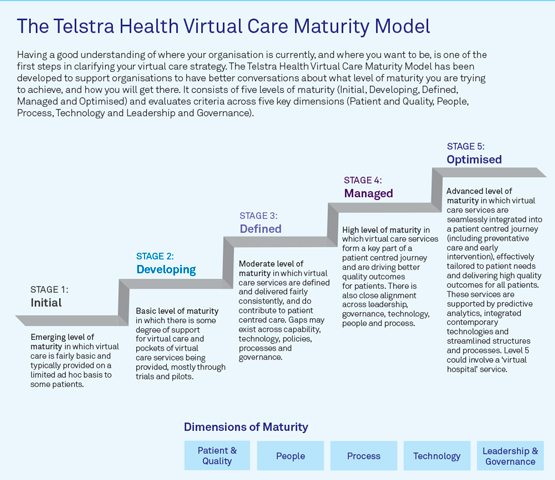
Sometimes it takes a global pandemic to push innovation from the fringes to the mainstream.
Virtual care has been gaining momentum for a number of years now, but while technology solutions have been readily available and increasingly sophisticated, uptake amongst healthcare providers has been limited. With the arrival of the COVID-19 virus in Australia, the need for virtual care was tangible and immediate. Several months into the pandemic, many healthcare providers made a start on their virtual care journey, but fast forward a couple of months and they are struggling with what to do next and what to aim for.
‘Virtual care’ means different things to different people. Telstra Health’s definition of virtual care focuses on helping connect providers and patients through technology to enable providers to support, manage and empower patients minimising the need for an in-person consultation. Virtual health at Telstra Health encompasses:
- Virtual clinical services, such as virtual consultation and coordination services
- Virtual health monitoring, to help enable the remote monitoring of a patient’s condition
- Virtual health connection, which includes the provision of communication, documentation and messaging services
The value of virtual health is substantial and growing. A recent evaluation of the rollout of the Connect@Home Respiratory service in Victoria demonstrated that patients using the service had lower rates of attendance to the Emergency Department, and patients gave the service a Net Promoter Score of 9.7.
Virtual care can also increase healthcare accessibility, particularly for patients living in rural and remote areas. The digital health offering helps open up new opportunities for early intervention and preventative care, can create improvements in efficiency and productivity, and can enhance care coordination between providers.
What Telstra Health has learned from working with providers
The majority of Telstra Health’s clients recognise the great potential virtual care can have, however many providers don’t know where to start, or are unclear as to how virtual care can help support them in scaling their services beyond an initial pilot.
Telstra Health has shared its learnings from some of the projects it has been involved in, and has identified the factors that led to a smooth integration of virtual care services within a provider.
Organisations that tend to succeed in their virtual care journey typically:
- Have a clear vision for virtual care, which is set by leadership and driven by the entire organisation. This helps organisations transition from initial pilots and trials to a mature virtual care service delivery model.
- Drive change across all dimensions, including quality of care, people, process, technology, leadership and governance. It’s important to consider how the spectrum of virtual care solutions can be used to help improve the model of care.
- Engage clinicians early, to secure their support and input into the development of the models of care.
- Use data and evidence to identify which services and patient groups are most appropriate for virtual care.
- Focus on the model of care as much as the technology, and are clear how they expect the model of care to change with the shift to virtual care.
- Tailor services appropriately to help meet the needs of different patient groups.
- Monitor and measure the effectiveness of their virtual care initiatives on an ongoing basis and look to achieve continuous improvement.
The Telstra Health Virtual Care Maturity Model
Having a good understanding of where your organisation is currently, and where you want to be, is one of the first steps in clarifying your virtual care strategy.
The Telstra Health Virtual Care Maturity Model has been developed to help organisations have better conversations about the level of maturity they are trying to achieve, and how they can get there. It consists of five levels of maturity (Initial, Developing, Defined, Managed and Optimised) and evaluates criteria across five key dimensions (Patient and Quality, People, Process, Technology and Leadership and Governance).

Telstra Health’s Virtual Care Maturity Model
Applying the Maturity Model
To apply the Maturity Model, Telstra Health works with clients to consider a range of questions.
- What is your organisation’s vision for virtual care?
The Maturity Model helps an organisation start the conversation about their vision for virtual care. For some organisations, a target maturity level of ‘Managed’ will be sufficient; others may be aiming to develop a level 5, optimised, ‘virtual first’ delivery model, and to become market leaders in virtual care provision. Your organisation’s vision for virtual care will ultimately depend on your overarching strategy and priorities, as well as the challenges you face, and hence clarity and consistency of vision amongst the organisation’s leaders is critical.
- How will your organisation get there?
Once you are clear what your vision for virtual care is, the next step is to consider how you will achieve that. While each organisation has its own challenges, there are a number of factors to consider to set your virtual care services up for success, these include:
- Which virtual care delivery model will you adopt?
Will you opt for a blended model in which face-to-face consultations and virtual care services either sit side-by-side or co-exist within the patient journey? Or will you look to establish a ‘virtual first’ model, with a virtual hospital or virtual command centre? How will this virtual care model support patient-centred care? - What capabilities do you need to support a virtual care delivery model?
How will the adoption of virtual care change the capabilities you need, and what can you do now to start planning for that? - What structures, processes and governance (clinical and corporate) will be required?
What mechanisms will need to be put in place to support effective virtual care service provision and decision-making, and to manage clinical risk? Is there a need for new or adapted processes, or changes to existing clinical and corporate governance structures? Will the way teams are structured need to change to support the new service model? - How will your clinical workforce be impacted?
How will the use of virtual services change clinical practice? Have the impacts on training and supervision been considered? Have you factored the use of virtual services into workforce planning, from a capacity and demand management perspective? - What additional technologies will be required?
What changes to the technology environment are needed to deliver on the virtual care vision? - What level of cultural change will be needed and how will we achieve it?
What are the change management challenges from a clinical perspective, and from a patient perspective, and which tactics will you use to manage them?

Considerations for Implementation
- How will you know when your organisation has achieved its vision?
Measuring the clinical outcomes and realising the benefits from virtual care is essential. As you uplift your maturity, you should look to establish and monitor a set of measures which indicate how well you are tracking towards your virtual care vision. This may involve measuring the uptake of virtual care services, patient satisfaction, improvements in patient health outcomes, patient wait times or Average Length of Stay. The measures will be specific to your organisation and should link directly to your strategic objectives and business case for investment.
It’s clear that virtual care is here to stay and will be a foundational component of the future healthcare landscape. In this article we hope to have provided you with a simple framework to start planning your virtual care journey. Now is the time to get started!
Need help?
Telstra Health offers a range of products and services to help you along your virtual care journey. Its Virtual Care Solutions team offers a range of integrated solutions for virtual care, including telehealth capabilities, virtual health monitoring and virtual health connection services. Telstra Health’s solutions are proven and used across a range of private and public healthcare organisations, including Mackay Base Hospital and WA Primary Health Alliance.
Telstra Health works with its Advisory Services Team to help provide you with end-to-end support on your virtual care journey, from strategy through to implementation and evaluation.
Telstra Health is here to support you and you can contact the team on 1800 HEALTH (1800 432 584).
This blog article is informational in nature and is not intended to be a substitute for professional advice.
